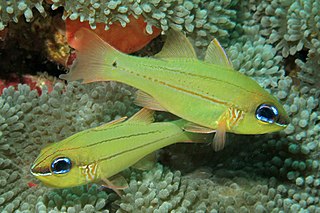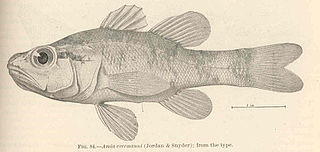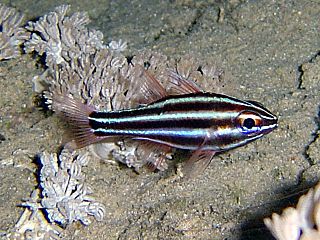
Ostorhinchus fleurieu is a species of cardinalfish native to the Red Sea and Persian Gulf, the Gulf of Oman, and the waters around East Africa, Seychelles, India, Sri Lanka, the Indo-Malayan region, and Hong Kong., south to the Ashmore Reef, Western Australia. It is the type species of the genus Ostorhinchus. The specific name honours the French explorer and hydrographer Charles Pierre Claret, comte de Fleurieu (1738-1810) who was a colleague and friend of Lacepède's.

The ring-tailed cardinalfish is a widespread fish species in the family Apogonidae found in the Red Sea and off East Africa to Papua New Guinea, north to Japan, and south to Australia.

Ostorhinchus cyanosoma, commonly known as the yellow-striped cardinalfish, goldenstriped cardinalfish, or the orange-lined cardinalfish, is a species of marine fish in the cardinalfish family of order Perciformes. It is native to the Indo-West Pacific.

Ostorhinchus compressus, commonly called the ochre-striped cardinalfish, blue-eyed cardinalfish or split banded cardinalfish, is a marine cardinalfish from the Indo-West Pacific from the family Apogonidae. It occasionally makes its way into the aquarium trade. It grows to a size of 12 cm in length.
Ostorhinchus hoevenii is a species of ray-finned fish from the family Apogonidae, the cardinalfishes, it is from the Indo-West Pacific north to Japan and south to Australia. It occasionally makes its way into the aquarium trade. It grows to a size of 6 cm in length. It occurs in small groups among corals, sea urchins, crinoids and algae. The specific name honours the Dutch zoologist Jan van der Hoeven (1801-1868).

Zoramia gilberti is a Cardinalfish from the Western Central Pacific. It occasionally makes its way into the aquarium trade. It grows to a size of 4.2 cm in length. It is found in sheltered bays and lagoons, where it gathers in large aggregations among branching corals, frequently mixed with other cardinalfish species. The specific name honours the American ichthyologist and fisheries biologist Charles H. Gilbert (1859-1928) of Stanford University who was a colleague of Jordan's.

Vincentia is a genus of cardinalfishes native to the eastern Indian Ocean and the southwestern Pacific Ocean. The generic name refers to Gulf St Vincent in South Australia, where the type specimen of V. waterhousii was collected.

Stanulus talboti, Talbot's blenny, is a species of combtooth blenny found in coral reefs in the western Pacific Ocean. This species feeds primarily on plants, including benthic algae and weeds. This species can reach 4.8 cm (1.9 in) in TL. This fish is also found in the aquarium trade.

Ostorhinchus neotes, the mini cardinalfish, is a species of ray-finned fish, a cardinalfish, from the family Apogonidae. It is found in the western central Pacific Ocean from the Philippines south to Australia and has been reported from Tonga. It is a small cardinalfish with a small semi-transparent body which has a black stripe along its flanks underneath the skin, and a large, black spot at the base of the caudal fin. It occurs in lagoons and outer reefs where the water is relatively clear and normally where there are soft corals or gorgonian fans. It forms small schools, but mates in couples and the male mouth broods the eggs. It shelters in crevices in the reef.

Ostorhinchus sealei, Seale's cardinalfish or the cheek-barred cardinalfish, is a species of ray-finned fish, a cardinalfish, from the family Apogonidae. It is an Indo-Pacific species which ranges from Malaysia east to the Solomon Islands, north to southern Japan and south to northwestern Australia, as well as Palau in Micronesia. It is an uncommon species which occurs among branching corals in the sheltered lagoons protected by reefs. It can be found in small to large aggregations low in the water over the reef. It is infrequent below depths of 10 metres (33 ft). They are mouthbrooders which form pairs to mate. During the day thse fish shelter in the reef and they emerge at night to feed on zooplankton and benthic invertebrates. The specific name honours the American ichthyologist Alvin Seale (1871-1958).

Fowleria is a genus of fishes in the family Apogonidae native to the Indian and Pacific Oceans. The name of this genus honors the American ichthyologist Henry Weed Fowler ( ) of the Academy of Natural Sciences of Philadelphia, who attended Stanford University, where he was a student of David Starr Jordan's.

Gymnapogon is a genus of fish in the family Apogonidae. They are native to the Indo-West Pacific and central Pacific Oceans, where they occur in reefs and nearby habitat types. These species are usually no more than 5 centimeters long and have semitransparent bodies without scales. The genus name is a compound noun formed by combining the Greek gymnos meaning "naked", referring to the lack of scales in the type species, Gymnapogon japonicus, and Apogon, the type genus of the Apogonidae. One species, the B-spot cardinalfish, is notable for its larvae being rather large, conspicuous and fast-swimming.
Lachneratus phasmaticus, also known as the phantom cardinalfish, is a species of fish in the family Apogonidae, the cardinalfishes. It is the only member of its genus. It is native to the tropical eastern Pacific and Indian Oceans. This fish can be found in crevices and underwater caves, and it occurs at depths of 3 to 104 m. It grows to a standard length of 7.4 cm (2.9 in).

Ostorhinchus is a genus of ray-finned fish in the family Apogonidae native to the Indian and Pacific Oceans.

Zapogon evermanni, Evermann's cardinalfish, is a species of cardinalfish native to tropical reefs in the Indian and Pacific Oceans and the western Atlantic Ocean.

Pristiapogon exostigma, also known as Eyeshadow cardinalfish or oneline cardinalfish, is a small pale ray-finned fish from the family Apogonidae, the cardinalfishes with light-ended black stripe ending in black spot above centre of stripe. It has an Indo-Pacific range which extends from the Red Sea to the Line Islands and Mangareva Islands and south to northern Australia and north to the Ryukyu Islands.

Ostorhinchus cookii, common names Cook's cardinalfish, Cook's soldierfish, blackbanded cardinal, blackbanded cardinalfish, is a species of marine fish in the family Apogonidae.

Jaydia queketti, the spotfin cardinal or signal cardinalfish, is a species of ray-finned fish from the Indian Ocean, it is a member of the family Apogonidae. It has colonised the eastern Mediterranean Sea by way of the Suez Canal since 2004.
Jaydia smithi, Smith's cardinalfish, is a species of ray-finned fish from the Indian and Pacific Oceans, a member of the family Apogonidae. It has colonised the eastern Mediterranean Sea by way of the Suez Canal since 2007.
Ostorhinchus flavus, the brassy cardinalfish or yellow cardinalfish, is a species of ray-finned fish from the family Apogonidae, the cardinalfishes. It occurs on the Great Barrier Reef and in the Coral Sea, as well as in the Tasman Sea at Lord Howe Island and at Norfolk Island. The species also occurs in the south-west Pacific. The males mouthbrood the eggs and the species forms pairs. It is similar in appearance to Ostorhinchus capricornis but this species has two white stripes through its eye rather than neon blue ones.
















